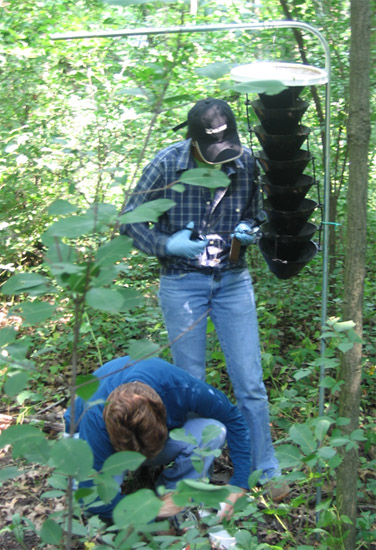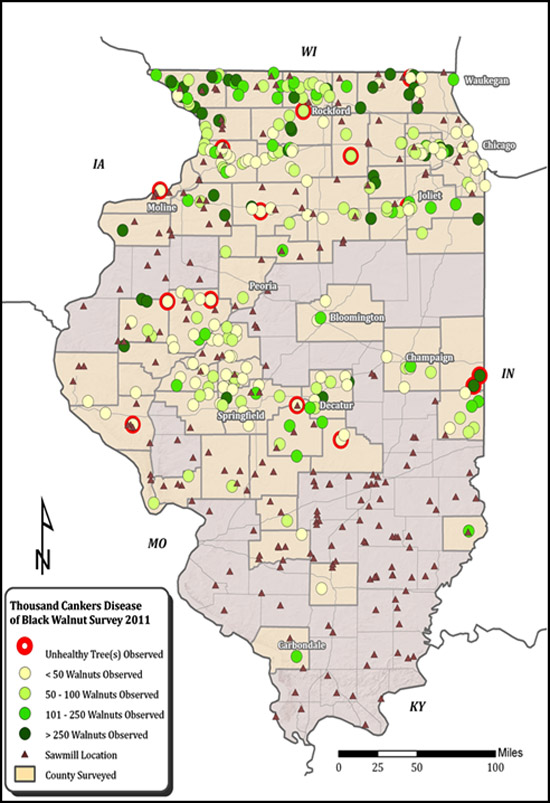Issue 18, October 22, 2012
Surveying for Illinois Invasive Species with the CAPS Program
This was published as a guest article for the Illinois Invasive Species Awareness Month Blog. We share it with the Home, Yard, and Garden readers to illustrate the importance of invasive species in our state and the risk they pose.
While a central geographic location and a superior transportation system afford Illinois a competitive advantage over many other states in commodity movement, these same factors make Illinois extremely vulnerable to accidentally or purposely introduced exotic pests. The U.S. imports nearly $400 billion in goods from the Pacific Rim; more than $125 billion from China alone. The busiest corridor in the U.S. for transporting intermodal containers by rail runs from Long Beach, California, to Chicago, Illinois, and Chicago in particular is home to the largest rail gateway in the nation, connecting eastern and western United States and Canada. An excellent highway system of 2,000 miles and 34,500 miles of other state highways make trucking of goods fast and efficient. More than 65 million travelers pass through Chicago's O'Hare International Airport annually. Illinois' 1,118 miles of navigable waterways including the Illinois and Mississippi Rivers, make barge traffic an excellent option for shipment of grain to the Gulf of Mexico and shipment of imported steel and machinery upriver. However, any activity that allows the rapid movement of commodities also allows the development of fast-moving pest pathways. These fast moving pathways not only cut through Illinois' agricultural commodity regions, but its natural areas as well. Illinois woodlands, wetlands, and prairies may also be affected by the potential invasion of exotic pests. Many of the invasive threats have a large host range. Not only will a potential invasive pest affect the Illinois economy, but it may also affect the beauty of our landscape, the diversity of our environment, and lead to the destruction of natural habitats.

While the first line of defense remains preventing the entry of exotic plant pests, domestic detection and response activities are equally important in the event that dangerous foreign plant pests enter the U.S. A primary objective of the Cooperative Agriculture Pest Survey (CAPS) program is to safeguard our nation's food and environmental security from exotic pests that threaten our production and ecological systems. Surveys conducted through the CAPS program represent a second line of defense against harmful plant pests and weeds. These surveys not only target high-risk hosts and commodities, but also gather information about pests that were recently introduced to establish better baseline data. These activities are accomplished primarily under USDA funding that is provided through cooperative agreements with state departments of agriculture, universities, and other entities.

Surveying for exotic bark beetles.
Surveys targeting high risk hosts and commodities. Over the past years, the CAPS program has shifted its strategy from being solely "pest-specific," to a format for surveying for several pests based on commodities, taxons, environments and habitats, industries and businesses, and pest introduction pathways. Each state, with input from federal and state CAPS partners, industry partners, university representatives, and others meets to discuss potential survey targets each year. These stakeholders help set survey priorities based on a prioritized PPQ pest list (based on risk of introduction and regulatory concern) and each state's resources, hosts, climates, and other factors.
Gathering data on recently introduced pests. Information gathered during surveys is summarized and entered into the National Agricultural Pest Information System (NAPIS) database. The NAPIS database stores and manages pest survey data that is collected by CAPS and other USDA-APHIS-PPQ programs. Maps are summarized and made available to the public through the NAPIS Pest Tracker Website. The Pest Tracker Website provides maps detailing surveys conducted around the U.S. for different invasive species as well as sharing links to pest news and information for the different states.
Currently, the Illinois CAPS program is finishing up its 2012 survey season. Our focus this last summer was on invasive pests of fruit trees in Illinois. Insect traps were deployed across the state for the False Codling Moth, Plum Fruit Moth, and Summer Fruit Tortrix Moth. All three of these moths have an extremely large host range that could impact several fruit commodities grown in Illinois. A second part of this survey looked for two state pests of concern -- the brown marmorated stink bug and spotted wing drosophila. To date, we have confirmed spotted wing drosophila in several Illinois counties. We are also in our second year of surveying for thousand cankers disease (TCD) in Illinois. It was our first year in utilizing a newly released lindgren funnel trap and pheromone combination that attracts the vector of TCD, the walnut twig beetle. While samples our still being processed from this past summer, we are looking forward to getting these traps out again in 2013.

Survey results from 2011 TCD Survey.
Also in 2013, we will be starting a new survey targeting oak pests. Over 53% of the forest cover in Illinois consists of oak and hickory--and this doesn't include any oaks planted in urban areas. There are several invasive oak pests that if established in Illinois, would not only threaten the diversity of our natural areas, but dramatically impact our forest product industry and nursery trade. Pheromone traps will be placed targeting the oak ambrosia beetle, Egyptian cottonworm moth, rosy gypsy moth, and golden tortrix moth. We are also excited to be utilizing a new biosurveillance survey technique that monitors Cerceris wasp colonies. This buprestid-hunting wasp offers another approach to monitor for not only emerald ash borer, but also the oak splendour beetle, goldspotted oak borer, and European oak borer.
Kelly Estes is the State Survey Coordinator for the Illinois CAPS program. Please check out the CAPS blog and website to keep up to date on invasive species information in Illinois. Feel free to contact her with questions or suspect invasive species.
Author:
Kelly Estes